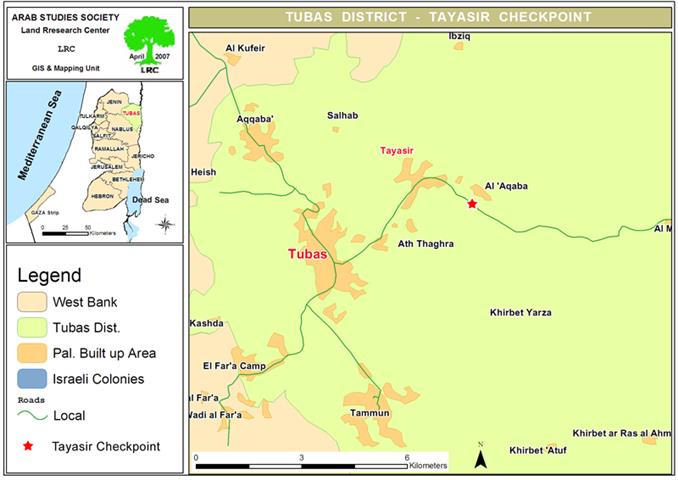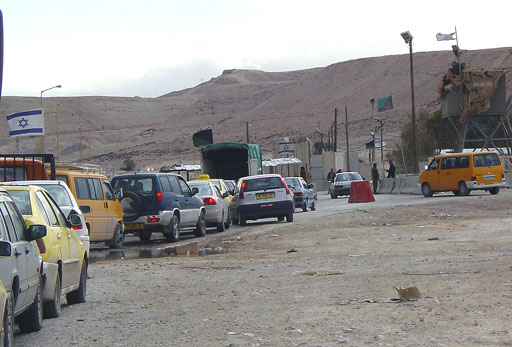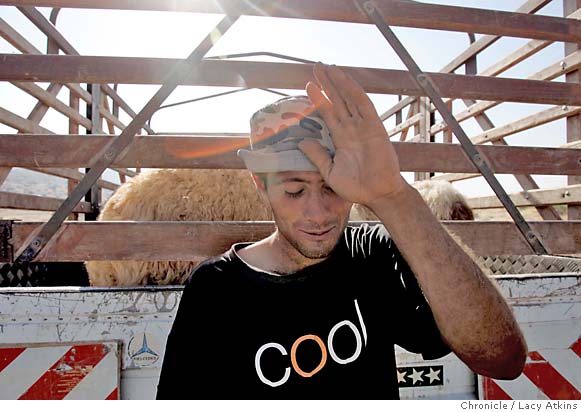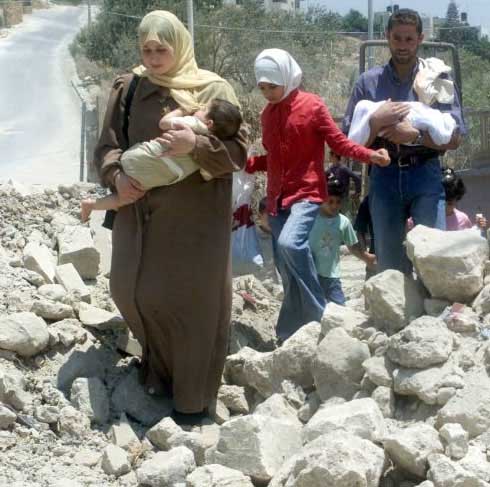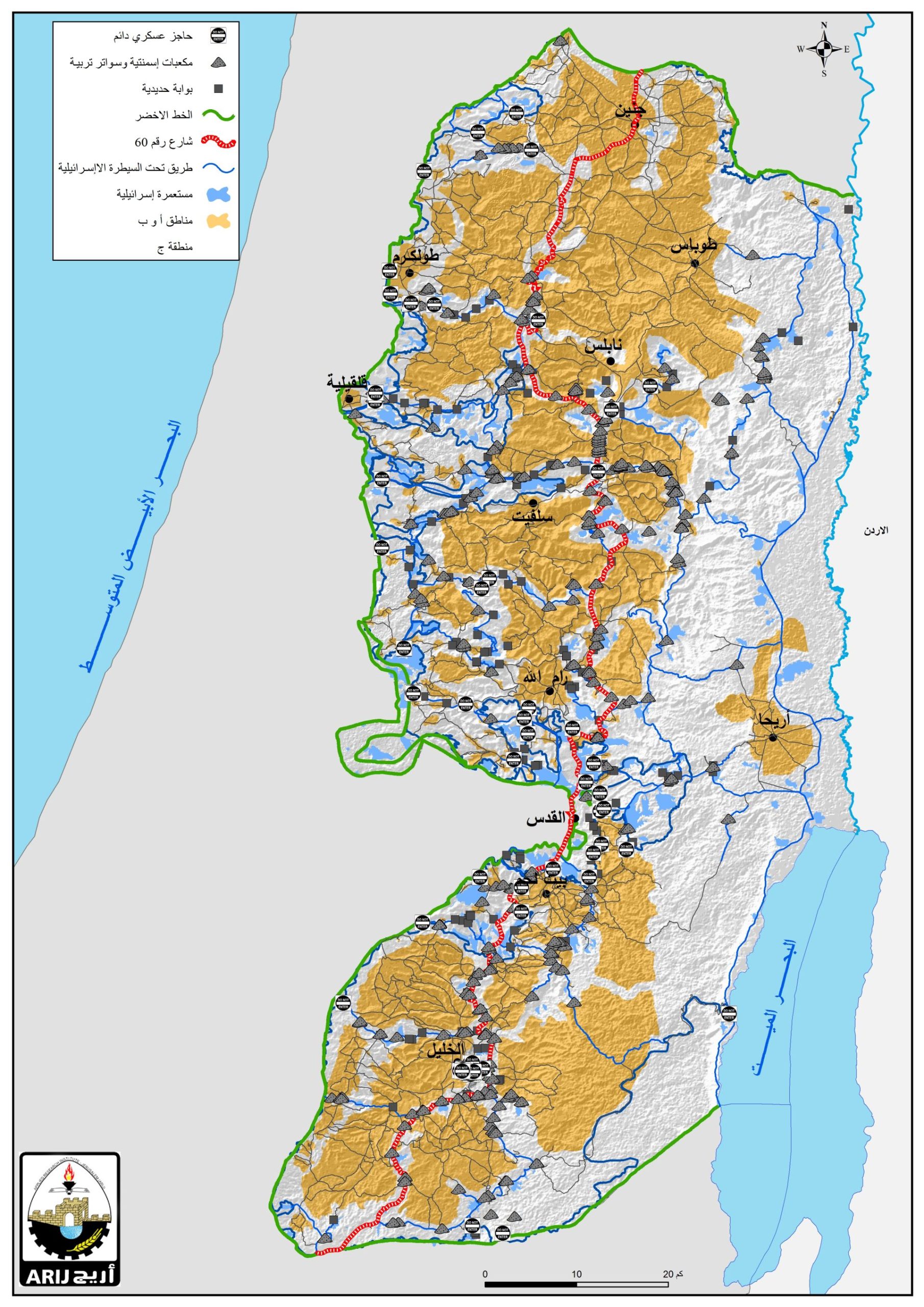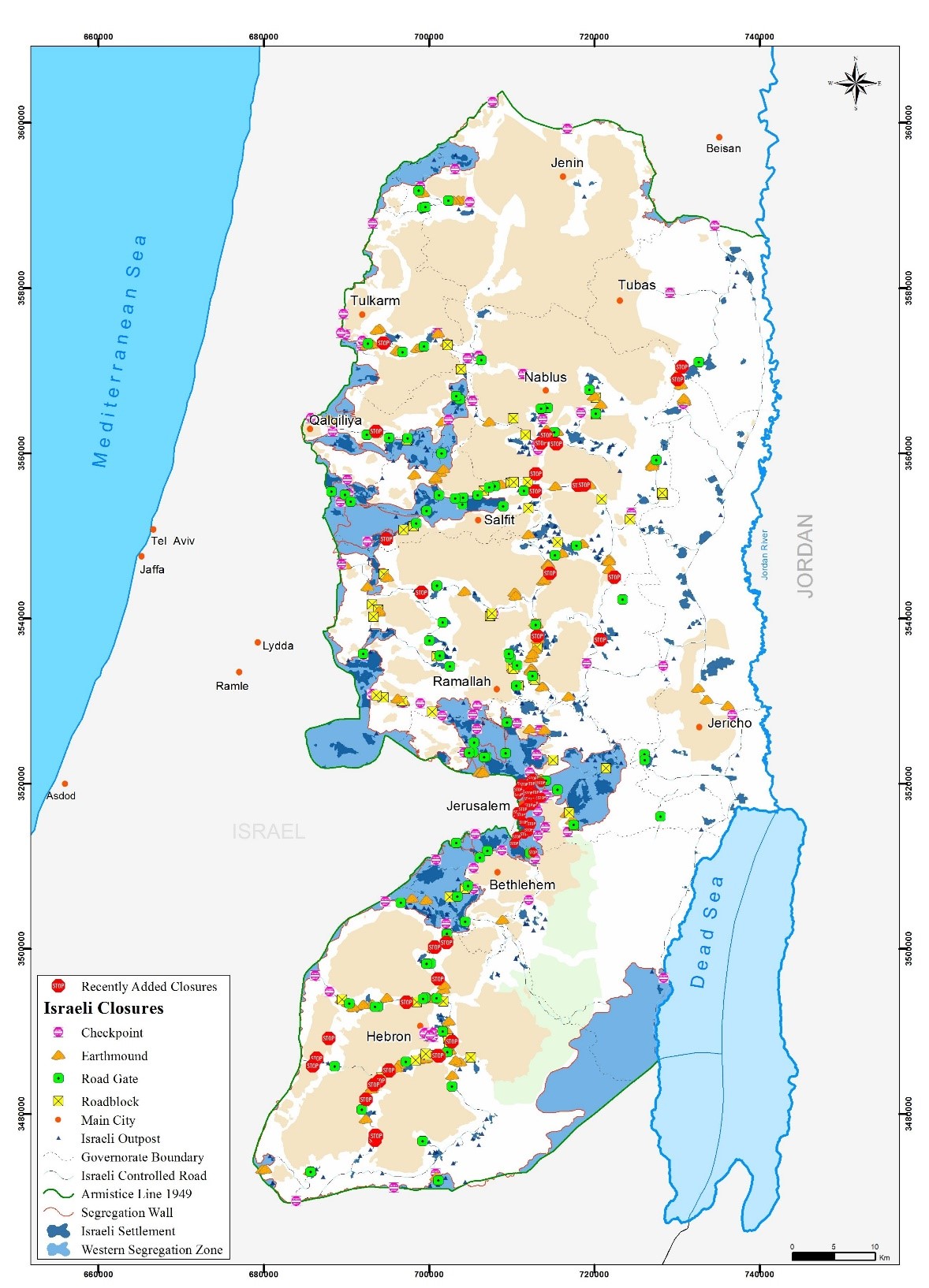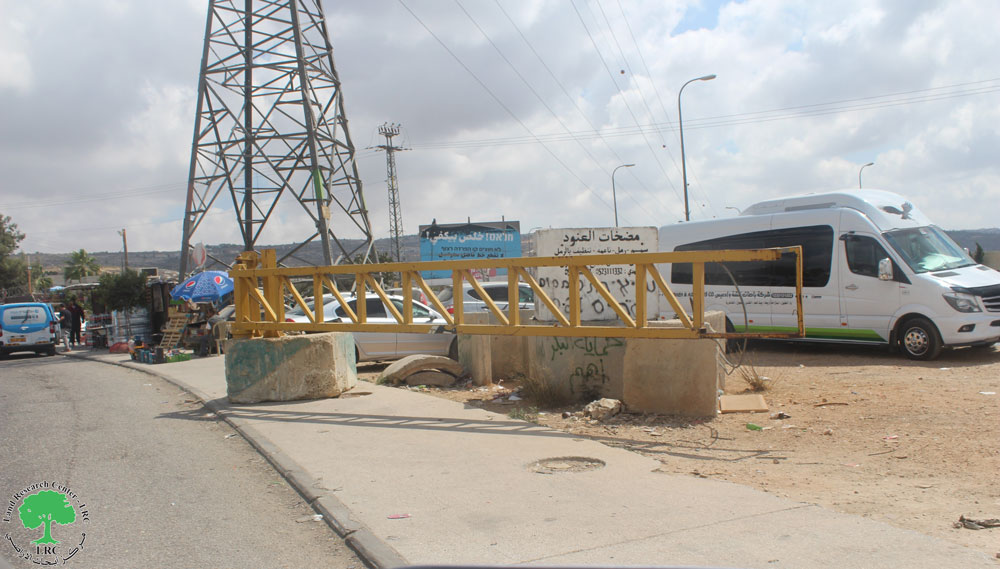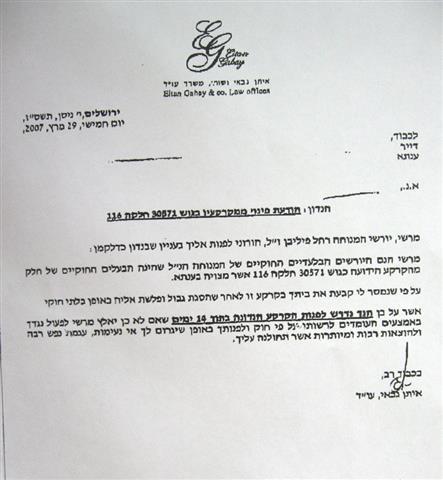Tayasir military Checkpoint
It that was established near the Jordan Valley at the outset of the Second Intifada. It is considered to be the first checkpoint that drew an eastern border of the West Bank. It has been recently replaced by a terminal-like building in which electronic devices are used.
(Map 1: location of Tayasir checkpoint )
Isolated Areas due to the checkpoint
The checkpoint will isolate all the area located between the Jordan River (in the eastern direction), the Green Line (in the northern direction), Jericho (southern direction) and 5 kilometers east of the city of Tubas.
Information indicates that the total area of the Israeli settlement located in the expected eastern isolation region is 37,997 dunums while the area of the Israeli military camps in the same region is 33,045 dunums. As for the area of the Closed Military Zone, it is 855,469 dunums while the estimated area of the eastern isolation region within the boundaries of the Jordan Valley is 1,664,026 dunums.
Tayasir checkpoint is a political checkpoint
Israeli occupation forces are implementing a policy of creating facts on the ground vis-à-vis the areas located to the east of the checkpoint through the exceptional measures it is currently implementing at the checkpoint. Such a policy aims at forcibly transferring the Palestinian population living there and to vacate the eastern ridges of its Palestinian residents in order to make available additional lands for the settlers to continue their Jordan Valley settlement project.
(Photo 1: cars waiting at Tayasir checkpoint)
The exceptional measures the Israeli occupation forces implement at the checkpoint include:
1. An exceptional rule called 'the bottleneck rule' which is not implemented anywhere else even at international crossing points.
2. Unlike other checkpoints throughout the West Bank, Tayasir checkpoint does not allow Palestinians residents of other governorates from passing through it.
3. On Tayasir checkpoint the IDF does not recognize permits issued by itself. !!
4. No Palestinian is allowed to access his land, house or his own family unless his ID card indicates that he is a resident of one of the villages in the northern Jordan Valley.
The Checkpoint and the International Media
The chance is now ample for the international and local media as well as human right organizations to document the different types of organized terrorism carried out by IDF soldiers at the checkpoint. Local media outlets have been reporting and exposing a number of brutality cases Palestinians go through while attempting to cross the checkpoint. Yet, for the most part the local media cannot capture all of the relevant details of such cases due to a number of factors. Moreover, the media have always looked upon the Tayasir checkpoint as yet another 'traditional' checkpoint that helps in the implementation of the Israeli Occupation Army's apartheid policy practiced for the past four years in this part of the West Bank.
However, when the issue is raised about the organized terror carried by one of Army's brigades working on the checkpoint, the situation becomes a bit different. Reports have indicated the presence of an Army Brigade whose soldiers are 'competing' on who would be able to cause more physical harm to Palestinian pedestrians away from the lenses and cameras of the media. Journalists and antiracism writers have indicated that the situation at this checkpoint differs remarkably from other checkpoints. Some of these writers went as far as declaring that soldiers' behavior is a clear violation of international law and can be classified as war crimes. Tens of different testimonies by Palestinian residents of Tubas and the Jordan Valley clearly shows that there is something out of the ordinary that the Israeli Army brigade manning the checkpoint has been doing for the past 4 years away from any international attention.
Racist Procedures at Tayasir Checkpoint are Against the Norms of International Law
Example of such treatment include an incident that took place in the spring of 2003 when one of the soldiers ordered one of the Palestinians to curse his own mother in front of all the Palestinians at the checkpoint in order to allow him to pass through. At another point in time, soldiers manning the checkpoint ordered a vegetable truck driver to list all Arab countries and then to curse them one by one before allowing him to cross the checkpoint.
Moreover, a number of incidents were reported where soldiers forced Palestinians at the checkpoint to take their clothes off. The latest such incident happened to an old man named Yousef Daraghma who was forced to take off his clothes before being handcuffed.
Another incident took place in the summer of 2003 when the soldiers at the checkpoint ordered the driver of a hay-filled truck to count all the hay before allowing him to proceed through the checkpoint!!!!. Similar treatment was practiced with a driver transporting tomatoes. Only a month ago, an Israeli soldier was caught on film while urinating in front of a group of Palestinian women heading to the Jordan Valley.
(Photo 2: a truck loaded with sheep is waiting at Tayasir checkpoint)
Tayasir Checkpoint … the Last Checkpoint before Entering the 'Jordan Valley' Ghetto
The mere existence of the Tayasir checkpoint (5 kilometers east of Tubas) increases the fears of the Palestinian population (n=40,000) that the checkpoint will become the official boundaries of Israel. Such a fear has been reinforced given the fact that lands located beyond the checkpoint into the Jordan Valley are restricted only to a few number of landowners. The discriminatory policies implemented on the checkpoint have prevented the population from working their lands inside the Valley while all other West Bankers are prohibited from entering the area.
After six years of its establishment, the residents of the nearby village of Tayasir (after which the checkpoint was named) have no option but to go through it to gain access in and out of the region. Otherwise, one faces the prospect of being killed or apprehended if heshe tries to use the rough mountainous road leading into the village. Israeli occupation forces had established the checkpoint at the beginning of the Intifada after sealing off the eastern ridges and the Jordan Valley in the face of the residents of the West Bank ever since.
Jordan Valley residents of Tubas origins point out that the checkpoint has become most infamous for its soldiers' sadistic practices due to the absence of media outlets in such a remote site in which the checkpoint is located in. Such a location is strategically placed as to function as a traffic bottleneck as nobody seeking entry or exit from the Jordan Valley can do so without using this checkpoint due to the difficult terrains and topography of the surrounding area.
Palestinian residents also indicate that upon the establishment of the checkpoint Israel had already have the intention to unilaterally declare its borders and that the checkpoint is one of its border points. Other points, according to Israeli sources, include strategic heights and a belt of settlements in the Jordan Valley reaching to its most northern parts. Ehud Olmert, the current Israeli Prime Minister, has reiterated in a number of occasions during his electoral campaign that Israel's permanent borders will be drawn in the next four years while indicating the inclusion of Gush Etzion settlement block, the vicinity of Jerusalem (including the settlement of Ma'ale Adumim), the settlement of Ariel in addition to the Jordan Valley which act as a natural defense line for Israel. On the ground, steps are being taken to annex the Jordan Valley without any world attention being paid to it.
According to Mr. Ouqab Daraghma, the head of Tubas Municipality, the Tayasir checkpoint had isolated tens of thousands of dunums owned by residents of Tubas and other nearby localities (such as Tamun who lost access to most of its lands due to the checkpoint). Such a checkpoint, according to him, was set for purely political reasons rather than for security purposes as the Israelis claim.
In addition to the Tayasir checkpoint (which effectively cut off transportation ties within the eastern part of the West Bank), Israeli occupation forces have established another checkpoint to serve the same purpose in the central parts of the Jordan Valley. Both of these checkpoints form a clamp on the entirety of the Jordan Valley.
The establishment of these two checkpoints, among other measures, are at the heart of 'solutions' the Israeli government is trying to impose upon the world; complete control over the Jordan Valley while implementing a set of policies (targeting the Palestinian agriculture, the establishment of the Wall and tunnels such is the case near Tamun) that targets the Palestinian population of the Valley in an effort to drive them out of it. All the military measures practiced in the Valley clearly point to such an intention and the intention of creating the eastern boundaries of Israel.
The frequency and harshness of Israeli announcements vis-à-vis the isolation of the Jordan Valley have been reduced recently. Yet, procedures on the ground are continuing to reach such a goal. The failure of the Israeli Army in the Lebanon war in the summer of 2006 in addition to the collapse of Kadima's 'Retraction Plan' has led to such a reduction. However, the procedures aiming at the continuation of the isolation of the Valley (area = 2,400 Km2 constituting around 30% of the total area of the West Bank) are still evident and increasing. Palestinian residents of the Valley have indicated that no easing of the Israeli restrictions has taken place. On the contrary, Israeli measures in the Valley have been tightened and intensified; for the past six years Palestinian residents of the West Bank are prevented from accessing the Valley through the checkpoints surrounding it. Israel, in turn, has not made its policies and procedures in the Valley public for fear of international criticism.
(Photo 3: A Palestinian family trying to avoid an Israeli checkpoint in Jordan valley)
The residents of the Valley, especially those living in Tamun and Tubas, have come to realize the dangers of the current situation which led them to carryout a number of protesting steps against the Israeli measures. The Israeli reaction was harsh as Palestinian houses and vegetable posts were demolished as a punishment.
Currently, a year after the Olmert isolation threats, Palestinian residents of the Jordan Valley are living their worst situation ever as no one form the West Bank can gain access to the Valley in accordance with the so-called 'ID Law' according to which any one whose ID dose not indicate his residency in the Valley would not be allowed to gain access to it. Even the Valley residents, who are immune against this 'Law', face considerable difficulties in crossing the checkpoints due to the different Israeli ”security' measures especially during Jewish holidays where access to the Valley would be prevented in addition to the invalidation of the traveling permits.
Moreover, a trip along Road 90 gives a clear indication that Israel has no intention whatsoever of pulling out of the fertile Valley; signs are written in Hebrew and are giving directions to the agricultural settlements stretching all along the Road. In addition to the tens of thousand of dunums planted with palm trees by Jewish settlers, there are tens of farms that produce fruits and vegetables that are exported under the label 'Produced in the Jordan Valley.' Such facts led the Palestinian population of the Jordan Valley to despair as they see themselves as a straw in an ocean of settlements as Israeli measures are becoming tougher as days go by. Wherever the Palestinians wan to go for their livelihood, they would be faced with Israeli measures that aim at pressurizing them to leave. For example, two weeks ago a raid was conducted by the Israeli occupation army on Palestinian grazing areas on the western edges of the Valley. Soldiers threatened the population there and ordered them to vacate the area. Such evicting attempts have been carried out for years, yet the Palestinians are resilient and keep on moving from grazing area to another as their departure from the region means the cleansing of the Palestinian presence there.
However, Israeli pressure and raids in the past few years had led to the migration of some Palestinian herders and their families from their usual residence places that usually overlooked the Jordan Valley. As such, areas such as Al Suwaida'a. Qatwa and Makhoul are nearly empty of Palestinians as a number of the families that used to live there have been reduced due to Palestinian migration prompted by the Israeli pressure.
Prepared by
The Land Research Center
LRC


